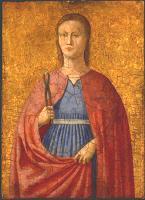Apollonia was born in Egypt in the 3rd century and died in 249. She was an elderly deaconess, living in Alexandria. She was martyred for not renouncing her faith during the reign of Emperor Philip[1]. One night, angry rioters violently attacked believers of the faith. Apollonia had all her teeth knocked out. After she was threatened with fire unless she renounced her faith, Apollonia jumped into the flames voluntarily. St. Augustine adamantly defended that as an act of heroic faith and not suicide, which would be unsaintly. In 300 AD, prior to Christianity becoming the Roman Empire’s official religion, she was canonized as St. Apollonia. Subsequently, she became the patron saint of toothache sufferers and of the dental profession.
Ancient art depicts her with a golden tooth at the end of her necklace. Also, in art she is seen with a pincers holding a tooth[2]. Parts of her jaw and many of her teeth are presently housed in churches across Europe[3]. Her feast day is February 9th.
The account of the martyrdom of St. Apollonia is contained in a letter by St. Dionysius[4] to Fabius, Bishop of Antioch[5]. In the ecclesiastical history of Eusebius Pamphilus : Bishop of Caesarea, in Palestine[6] (book VI, chapter 41), is the letter from Dionysius which provides the only historical document of the persecution at Alexandria, and what we really know of Saint Apollonia.
“The persecution with us did not begin with the imperial edict[7], but preceded it a whole year. And a certain prophet and poet excited the mass of the heathen against us, stirring them up to their native superstition. Stimulated by him, and taking full liberty to exercise any kind of wickedness, they considered this the only way of showing their piety – to slay us. First, then, seizing a certain aged man, named Metras, they called on him to utter impious expressions, and as he did not obey, they beat his body with clubs, and pricked his face and eyes; after which they led him away to the suburbs, where they stoned him.”
The letter continues about a woman named Quinta who was stoned and further about Apollonia:
“Then with one accord, all rushed upon the houses of the pious, and whomsoever of their neighbors they knew, they drove thither in all haste, and despoiled and plundered them, setting apart the more valuable of the articles for themselves; but the more common and wooden furniture they threw about and burnt in the roads, presenting a sight like a city taken by the enemy. They also seized that admirable virgin[8] Apollonia, then in advanced age, and beating her jaws, they broke out all her teeth, and kindling a fire before the city, threatened to burn her alive, unless she would repeat their impious expressions. She appeared at first to shrink a little, but when suffered to go, she suddenly sprang into the fire and was consumed.”
[1] Marcus Julius Philippus (Latin: Marcus Julius Philippus Augustus c. 204 – September 249 AD), also known commonly by his nickname Philip the Arab (Latin: Philippus Arabus, also known as Philip I), was Roman Emperor from February 244 to September 249.
[2] http://www.virtualdentalmuseum.org/exhibits/st-apollonia-gallery/
[3] Fragments of her head and teeth were rescued from the ashes by devout disciples, and today her relics are scattered throughout Europe; stray bits of her have even reached America. Her head is in the ancient Basilica of Santa Maria in Trastevere at Rome, Cardinal Gibbon’s parish church or titular, for every Cardinal has his own church in the Eternal City. Her arms are in another old Roman church, Saint Lawrence, outside the walk; and part of her jaw is preserved in San Basilio also in Rome. There are teeth or pieces of them in churches at Naples, Volterra, Bologna. Antwerp, Brussels, Malines, Liege, and in five different churches in Cologne; and on this side of the Atlantic, as I have said, the celebrated pilgrimage church of Saint Anne de Beaupre, near Quelle, is said to possess a portion of her jaw. https://catholicsaints.info/saint-apollonia-the-patron-saint-of-dentistry/
[4] St. Dionysius of Alexandria Letters and Treatises https://www.gutenberg.org/files/36539/36539-h/36539-h.htm Saint Dionysius the Great was the 14th Pope and Patriarch of Alexandria (Coptic Orthodox Church of Alexandria) from 28 December 248 until his death on 22 March 264. Most information known about him comes from his large surviving correspondence. Only one original letter survives to this day; the remaining letters are excerpted in the works of Eusebius.
[5] Fabius Bishop of Antioch (253–256)
[6] The ecclesiastical history of Eusebius Pamphilus : Bishop of Caesarea, in Palestine. https://openlibrary.org/books/OL14005648M/The_ecclesiastical_history_of_Eusebius_Pamphilus; Eusebius of Caesarea, also called Eusebius Pamphili, was among other things an ecclesiastical historian whose account of the first centuries of Christianity, in his Ecclesiastical History, is a landmark in Christian historiography.
[7] Decian persecution resulted from an edict issued in 250 AD by the Emperor Decius ordering everyone in the Roman Empire (except for Jews, who were exempted) to perform a sacrifice to the Roman gods and the well-being of the Emperor. The edict ordered that the sacrifices be performed in the presence of a Roman magistrate, and a signed and witnessed certificate be issued to that effect. It was the first time that Christians had faced legislation forcing them to choose between their religious beliefs and death, although there is no evidence that Decius’ edict was specifically intended to target Christians. The edict appears to have been designed more as an Empire-wide loyalty oath. Nevertheless, a number of Christians were put to death for refusing to perform the sacrifices, many others apostatized and performed the ceremonies, and others went into hiding. https://en.wikipedia.org/wiki/Decian_persecution
[8] parthenos presbutis (virgo presbytera) by which he very probably means not a virgin advanced in years, but a deaconess; http://www.newadvent.org/cathen/01617c.htm

